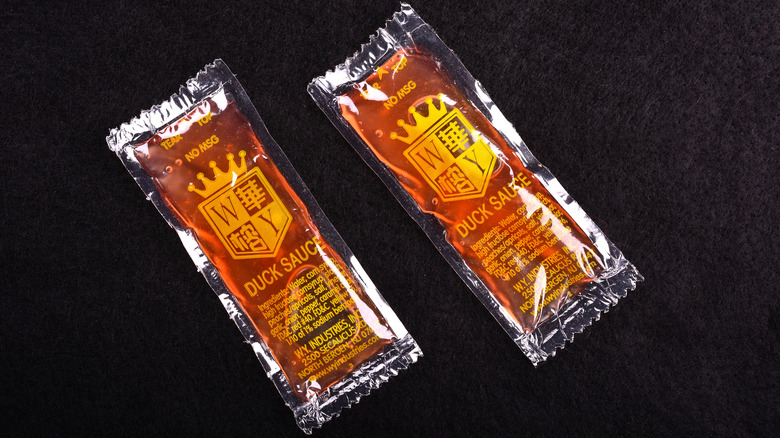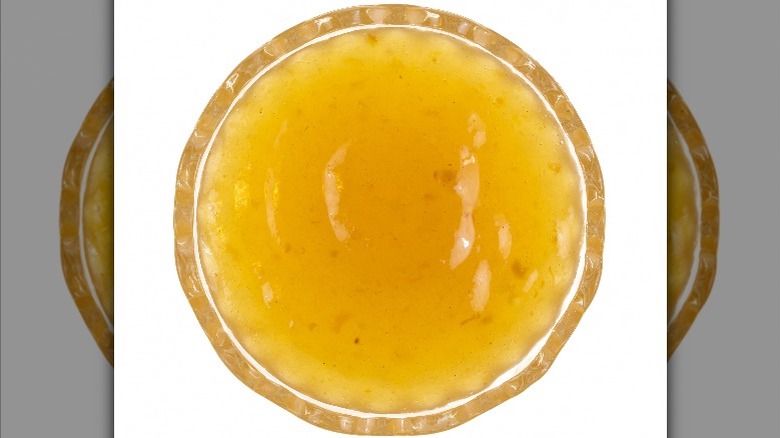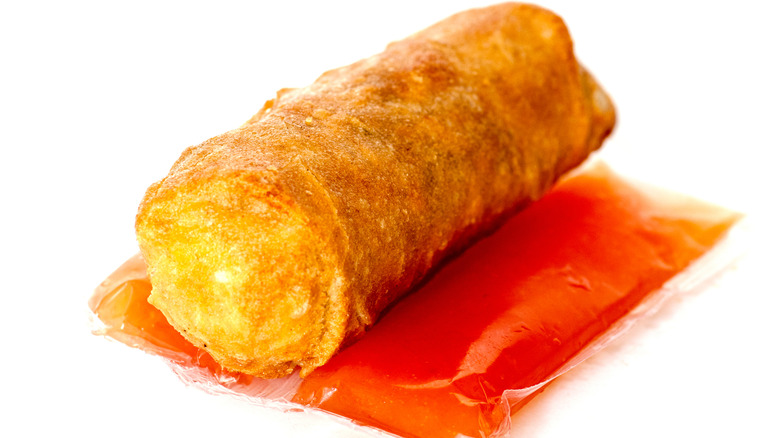The Unexpected Mystery Surrounding Duck Sauce
What do we mean when we talk about "duck sauce?" Yes, duck sauce, the little packets that are mixed in with hot mustard and soy sauce along with your Chinese takeout — and that likely end up on all sorts of things that don't contain duck meat. For most Americans, the name "duck sauce" conjures up a certain mental image, but where you're from determines what that actually is.
The duck sauce of the Midwest and Mid-Atlantic regions is a bright yellow, almost jam-like sauce. However, in New England, people are used to a darker, almost brown sauce. Even more strange is that duck sauce is almost unheard of on the West Coast, while in the rest of the country, it's used to adorn noodles and fried foods like egg rolls (which also have a mysterious origin) or crab Rangoon. This is all likely due to the fact that, like many things served in Chinese American restaurants, duck sauce is an American invention.
Which begs the question, just where does duck sauce come from, and why it is so region-specific?
The convoluted history of duck sauce
Duck sauce's true origins are a mystery and a highly debated subject. There is still enough evidence to provide some answers, though.
The reason that it's called "duck sauce" in the first place is likely that the recipe was an attempt by Chinese chefs coming to America to recreate the sauce that is traditionally served with Peking duck. Typically, this is a sauce that is made with wheat flour and soybeans, and it would probably have been a challenge for early Chinese immigrants to find soybeans, which are scarce in the United States. Instead, they would resort to more local ingredients as substitutions. It seems that, in the Mid-Atlantic, this was apricot, which serves as the central flavoring-agent in the bright-yellow variety, while in New England, they opted instead for applesauce and molasses.
Another possible origin for the sauce is that, instead of trying to recreate Peking duck sauce directly, chefs would turn to another condiment for inspiration. This may have been plum sauce, which is a dark brown sauce that's sometimes served with roasted duck. Just like in the first scenario, Chinese-immigrant chefs may have chosen to use more local ingredients in their concoctions.
It's also possible that both of these theories are true, and multiple different chefs were simply trying to duplicate something familiar with new ingredients. So, different versions caught on in separate regions.
Why is there no duck sauce in the West?
These narratives might explain the region-specific nature of duck sauce, but they still leave its absence on the West Coast a mystery. The answer likely involves the history of Chinese immigration into the United States.
Most consider the history of Chinese immigration to America to have come in two waves. The first was in the mid-1800s, and the majority of these immigrants were establishing themselves as laborers on the West Coast. Due to American legislation like the Chinese Exclusion Act of 1882, that flow of immigration was effectively stopped until the 1960s. It's then that the United States saw a loosening of these immigration policies and a serious growth in Chinese immigration yet again.
Sometime in the 1970s, amid the second wave of immigration, we see the first records of small plastic packets filled with duck sauce (and the same for soy sauce). They originally came from Bohemia, New York, and were made by a company called W.Y. Industries. Duck sauce may have already existed then, but the invention of these takeaway-packets made them more ubiquitous.
It's likely the idea of Chinese restaurants on the West Coast was well-established by this point. That meant people's preferences were probably already cemented, and there was no space left for duck sauce, which had only gained a foothold in more eastern regions.


